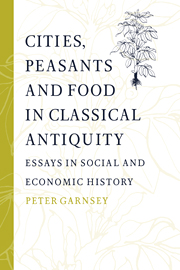Book contents
- Frontmatter
- Contents
- Preface
- Editor's preface
- Acknowledgements
- List of abbreviations
- PART I CITIES
- 1 Aspects of the decline of the urban aristocracy in the empire
- 2 Independent freedmen and the economy of Roman Italy under the Principate
- 3 Economy and society of Mediolanum under the Principate
- 4 Urban property investment in Roman society
- 5 An association of builders in late antique Sardis
- PART II PEASANTS
- PART III FOOD
- Bibliography
- Index
2 - Independent freedmen and the economy of Roman Italy under the Principate
Published online by Cambridge University Press: 02 December 2009
- Frontmatter
- Contents
- Preface
- Editor's preface
- Acknowledgements
- List of abbreviations
- PART I CITIES
- 1 Aspects of the decline of the urban aristocracy in the empire
- 2 Independent freedmen and the economy of Roman Italy under the Principate
- 3 Economy and society of Mediolanum under the Principate
- 4 Urban property investment in Roman society
- 5 An association of builders in late antique Sardis
- PART II PEASANTS
- PART III FOOD
- Bibliography
- Index
Summary
Freedmen in Rome and Italy were heavily involved in industrial and commercial activities and were also owners of property, both rural and urban, on a considerable scale. These facts are relatively well-known, although the evidence has not been systematically collected and analysed. The surveys of Kühn and Gummerus were concerned basically with artisans and drew only on the inscriptions of Rome and other Italian centres; they need to be broadened, corrected and brought up to date. Meanwhile one must bear in mind that such surveys have serious limitations, which prevent us from arriving at an accurate assessment of how the work-force was divided according to status. These limitations include the frequent absence of explicit status-indications, and the unrepresentativeness of the surviving sample of inscriptions, which is biassed towards those with a special reason for having themselves commemorated, namely freedmen, and in general towards better-off artisans and traders.
My present purpose is not to establish the active involvement or numerical dominance of freedmen in this or that sector of the economy, but to try to understand the phenomenon of the successful freedman, the possessor of moderate or substantial means, in the context of the economy and society of Italy in the period of the Principate. Examples of wealthy freedmen abound in the sources. For example, a metric inscription from the age of Augustus records how the noble Aurelius Cotta gave his II freedman Zosimus an equestrian fortune several times over, while a contemporary of his, the freedman Isidorus, left according to the elder Pliny 4,116 slaves, 3,600 teams of oxen, 257,000 other animals and sixty million sesterces in cash.
- Type
- Chapter
- Information
- Cities, Peasants and Food in Classical AntiquityEssays in Social and Economic History, pp. 28 - 44Publisher: Cambridge University PressPrint publication year: 1998
- 1
- Cited by



